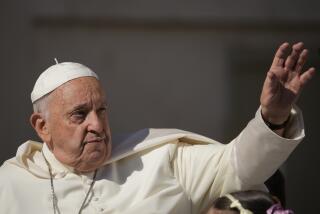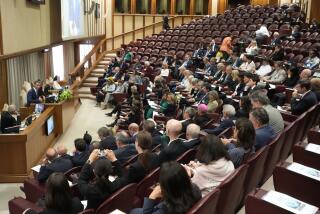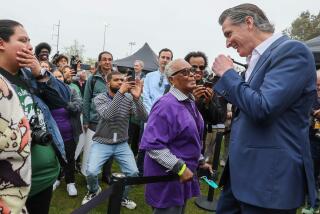The Papal Visit : Exchange of Ideas With John Paul Are Staged With Care
PHOENIX — In order to add a little “give and take” to many of Pope John Paul II’s presentations during his 10-day U.S. tour, a variety of people--ranging from high school students to bishops--were chosen to speak to the pontiff just before he gives his speeches.
Some have pleaded special causes for the Pope’s attention; others, ever so respectfully and subtly, have asked him to consider changes in church positions or policies.
But the exchanges are anything but spontaneous or off-the-cuff.
The “limited structural dialogues,” as papal-trip planners call them, consist of a prepared speech or speeches to the pontiff, followed by a prepared response from him. The Pope received the texts of all the messages, with one exception, by late June. Thus he had plenty of time to reflect upon and draft his responses.
‘No Real Spontaneity’
“There is no real spontaneity between the two partners to the dialogue,” conceded Russell Shaw, communications director for the U.S. bishops, who were instrumental in setting up the dialogue meetings for the Pope’s nine-city U.S. trip.
“But,” Shaw said, “that doesn’t spoil the effect. It’s a real presentation of two points of view from two parties expressed over a period of time. It’s kind of like an exchange of letters.”
If so, those of the Pope are crafted with unusual care. Ideas for John Paul’s talks were culled from drafts proposed many months ago by priests and bishops in this country. These suggestions were then reviewed by a planning committee in Washington.
The ideas for the talks were transmitted to the Vatican, where they were reviewed under the direction of Archbishop Justin Rigali, a Los Angeles native who now heads the Vatican diplomatic school. John Paul himself, officials say, wrote much of the material in the 49 speeches he is delivering on this trip.
Some of the 40 people addressing the Pope, such as Alfretta Antone, a Pima Indian who spoke Monday about the concerns of American Indians, represent specific interest groups.
Others, such as Sally Davis, a high school senior in New Orleans, won out in competition against 20 of her peers to be one of several young people to speak to the Pope at a youth rally in the Superdome.
None of the speeches to the Pope was censored, Shaw said. Staff members of the National Council of Catholic Bishops and, in some cases, the head of the committee or group involved in the dialogue read the texts beforehand. Sometimes suggestions were made, according to Shaw.
“Frankly, many of the texts were too long and had to be shortened,” he said.
No similar dialogue process occurred during the Pope’s 1979 pastoral visit to the United States, although several leaders made brief speeches to the Pope.
One, Sister Theresa Kane, president of the Leadership Conference of Women Religious, departed from a short prepared text to challenge the Pope to consider allowing women priests. Her impromptu remarks shocked church leaders and drew a brief, but pointed, rebuttal from the Pope, who indicated that women’s ordination was not an option.
So far, talks to the Pope on this journey have been polite but frank.
Many of the speeches have represented a consensus of thinking by the group the speaker represented. Father Frank J. McNulty, the New Jersey priest who told the pontiff in Miami about the “joys, concerns, worries and hopes” of U.S. priests, received suggestions from priests’ councils in each of the nation’s 185 dioceses. But McNulty, vicar for priests in the Archdiocese of New Jersey, personally drafted the talk.
In Los Angeles, when four of the nation’s bishops address the Pope on assigned topics at a closed meeting Wednesday, they will summarize ideas gleaned from other members of the hierarchy, Shaw said.
But, he added, it is possible that during the several hours that John Paul and the 380 prelates are together at Our Lady Queen of Angels Seminary in Mission Hills “some spontaneous remarks may flow back and forth.”
In the case of the four non-Christian groups meeting with the pontiff Wednesday afternoon at the Japanese American Cultural Center in Little Tokyo, the local organizations representing the Buddhist, Hindu, Muslim and Jewish faiths chose their own representative speakers. The pontiff has seen their advance texts.
In Miami, where one designated Jewish official addressed the Pope, a last-minute change was made because Rabbi Gilbert Klaperman, an Orthodox rabbi, was told by his group that it would be inappropriate for him to be the spokesman in light of the Pope’s June audience with Austrian President Kurt Waldheim, who is accused of covering up a wartime Nazi past.
Rabbi Mordecai Waxman, the past president of the Synagogue Council of America, delivered Klaperman’s message to the Pope instead.
The Pope didn’t see the revised draft of that speech until a few days before the Sept. 10 meeting, Shaw said, because it was rewritten after a meeting between nine high-level U.S. Jewish leaders and the Pope in Rome on Sept. 1 to discuss the Waldheim affair, the Holocaust and the Vatican’s refusal to grant full diplomatic recognition to Israel.
More to Read
Sign up for Essential California
The most important California stories and recommendations in your inbox every morning.
You may occasionally receive promotional content from the Los Angeles Times.










